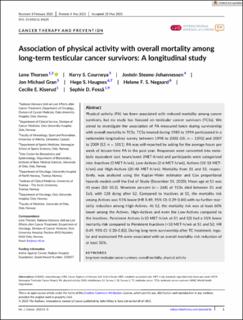| dc.contributor.author | Thorsen, Lene | |
| dc.contributor.author | Courneya, Kerry S. | |
| dc.contributor.author | Steene-Johannessen, Jostein | |
| dc.contributor.author | Gran, Jon Michael | |
| dc.contributor.author | Haugnes, Hege Sagstuen | |
| dc.contributor.author | Negaard, Helene Francisca Stigter | |
| dc.contributor.author | Kiserud, Cecilie E. | |
| dc.contributor.author | Fosså, Sophie Dorothea | |
| dc.date.accessioned | 2023-10-12T12:43:18Z | |
| dc.date.available | 2023-10-12T12:43:18Z | |
| dc.date.created | 2023-06-29T10:48:31Z | |
| dc.date.issued | 2023 | |
| dc.identifier.citation | International Journal of Cancer. 2023, 153(8), Side 1512-1519. | en_US |
| dc.identifier.issn | 0020-7136 | |
| dc.identifier.uri | https://hdl.handle.net/11250/3096138 | |
| dc.description | This is an open access article under the terms of the Creative Commons Attribution License, which permits use, distribution and reproduction in any medium, provided the original work is properly cited. | en_US |
| dc.description.abstract | Physical activity (PA) has been associated with reduced mortality among cancer survivors, but no study has focused on testicular cancer survivors (TCSs). We aimed to investigate the association of PA measured twice during survivorship with overall mortality in TCSs. TCSs treated during 1980 to 1994 participated in a nationwide longitudinal survey between 1998 to 2002 (S1: n = 1392) and 2007 to 2009 (S2: n = 1011). PA was self-reported by asking for the average hours per week of leisure-time PA in the past year. Responses were converted into metabolic equivalent task hours/week (MET-h/wk) and participants were categorized into: Inactives (0 MET-h/wk), Low-Actives (2-6 MET-h/wk), Actives (10-18 MET-h/wk) and High-Actives (20-48 MET-h/wk). Mortality from S1 and S2, respectively, was analyzed using the Kaplan-Meier estimator and Cox proportional hazards models until the End of Study (December 31, 2020). Mean age at S1 was 45 years (SD 10.2). Nineteen percent (n = 268) of TCSs died between S1 and EoS, with 138 dying after S2. Compared to Inactives at S1, the mortality risk among Actives was 51% lower (HR 0.49, 95% CI: 0.29-0.84) with no further mortality reduction among High-Actives. At S2, the mortality risk was at least 60% lower among the Actives, High-Actives and even the Low-Actives compared to the Inactives. Persistent Actives (≥10 MET-h/wk at S1 and S2) had a 51% lower mortality risk compared to Persistent Inactives (<10 MET-h/wk at S1 and S2; HR 0.49, 95% CI: 0.30-0.82). During long-term survivorship after TC treatment, regular and maintained PA were associated with an overall mortality risk reduction of at least 50%. | en_US |
| dc.language.iso | eng | en_US |
| dc.subject | long-term testicular cancer survivors | en_US |
| dc.subject | overall mortality | en_US |
| dc.subject | physical activity | en_US |
| dc.title | Association of physical activity with overall mortality among long-term testicular cancer survivors: A longitudinal study | en_US |
| dc.type | Peer reviewed | en_US |
| dc.type | Journal article | en_US |
| dc.description.version | publishedVersion | en_US |
| dc.rights.holder | © 2023 The Authors | en_US |
| dc.source.pagenumber | 1512-1519 | en_US |
| dc.source.volume | 153 | en_US |
| dc.source.journal | International Journal of Cancer | en_US |
| dc.source.issue | 8 | en_US |
| dc.identifier.doi | 10.1002/ijc.34625 | |
| dc.identifier.cristin | 2159364 | |
| dc.description.localcode | Institutt for idrettsmedisinske fag / Department of Sports Medicine | en_US |
| cristin.ispublished | true | |
| cristin.fulltext | original | |
| cristin.qualitycode | 2 | |

